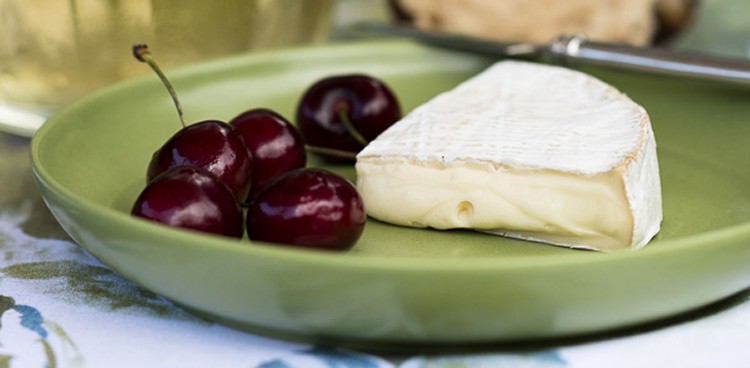

Planet Cheese is a weekly blog devoted to everything cheese: products, people, places, news, and views. James Beard Award–winning journalist Janet Fletcher writes Planet Cheese from her home in Napa Valley. Janet is the author of Cheese & Wine, Cheese & Beer, and The Cheese Course and an occasional contributor to culture. Visit janetfletcher.com to sign up for Planet Cheese and view Janet’s current schedule of cheese appreciation classes.
A thin rind, supple interior and captivating aroma are what I look for in Camembert-type cheeses. Oh, and no bitterness, no ammonia and just the right amount of salt. Is that too much to ask? Well, it must not be easy to nail, especially with pasteurized milk. Certainly I’m often disappointed. So when a bloomy-rind cheese hits all those targets—as this one does—I’m eager to talk it up.
Mt. Alice (pictured above) isn’t a new cheese, but it’s new to the West Coast. Von Trapp Farmstead, the Vermont producer, has been making it for about five years but keeping it in the Northeast until recently. With production growing, there’s now a little for the Left Coast. Thank you for sharing.
Sebastian von Trapp makes the cheese with the organic milk of his family’s small herd. His grandparents, Austrian immigrants (yes, those von Trapps), purchased the property 50 years ago and began dairy farming. His parents transitioned to organic production for a competitive edge. Sebastian and his brother, who has since moved on, launched the cheese making to add more value to the milk. For the brothers, the objective from the start was to prove that a small, grass-based dairy farm—they milk about 50 cows—could support their families and provide a template for others.
“No one’s getting rich,” Sebastian told me recently, “but we’re making it work. For three years now, we’ve been turning all our milk into cheese. That was a momentous thing, when we could stop shipping milk to Organic Valley.”

Alas, cheese alone is not enough. The family now supplements the bottom line by raising whey-fed pigs and “finishing” the young steers that they used to send to an auction house. Their retired dairy cows contribute yet more value as organic ground beef packaged under the von Trapp label. In the past, the cows were sold at auction and their meat was mixed with conventional beef.
The creamery’s washed-rind cheese, Oma, has been a favorite of mine since its debut, so I should not be surprised that Mt. Alice is just as engaging. Sebastian says he has stopped describing it as Camembert-style because the recipe is a little different—Mt. Alice is larger, for one thing, and the curd is not hand-ladled into the forms—but you will see similarities more than any differences.
Weighing a little over one pound, Mt. Alice is produced with pasteurized milk, traditional Camembert cultures and animal rennet. It matures for two to three weeks at the creamery, then gets pushed out of the nest. It’s probably four to six weeks old by the time most consumers try it, and it won’t last much longer than that.
The rind is thin, tender and edible; the interior silky and spreadable. A ripe wedge smells like porcini mushrooms sautéed in butter, with a beefy finish. Some may find the cheese a hair too salty; I’m on the fence about that.
Serve Mt. Alice with a rich white wine, like a white Burgundy; with dry cider; or with a supple red such as Merlot. Beer fans, open a saison. In Northern California, look for Mt. Alice at Farmstead Cheeses & Wines in Alameda and Montclair; Cheese Board in Berkeley; Sacred Wheel in Oakland; Cheese Plus, Mission Cheese and Rainbow Grocery in San Francisco; SHED in Healdsburg; and Atelier by JCB in Yountville.




